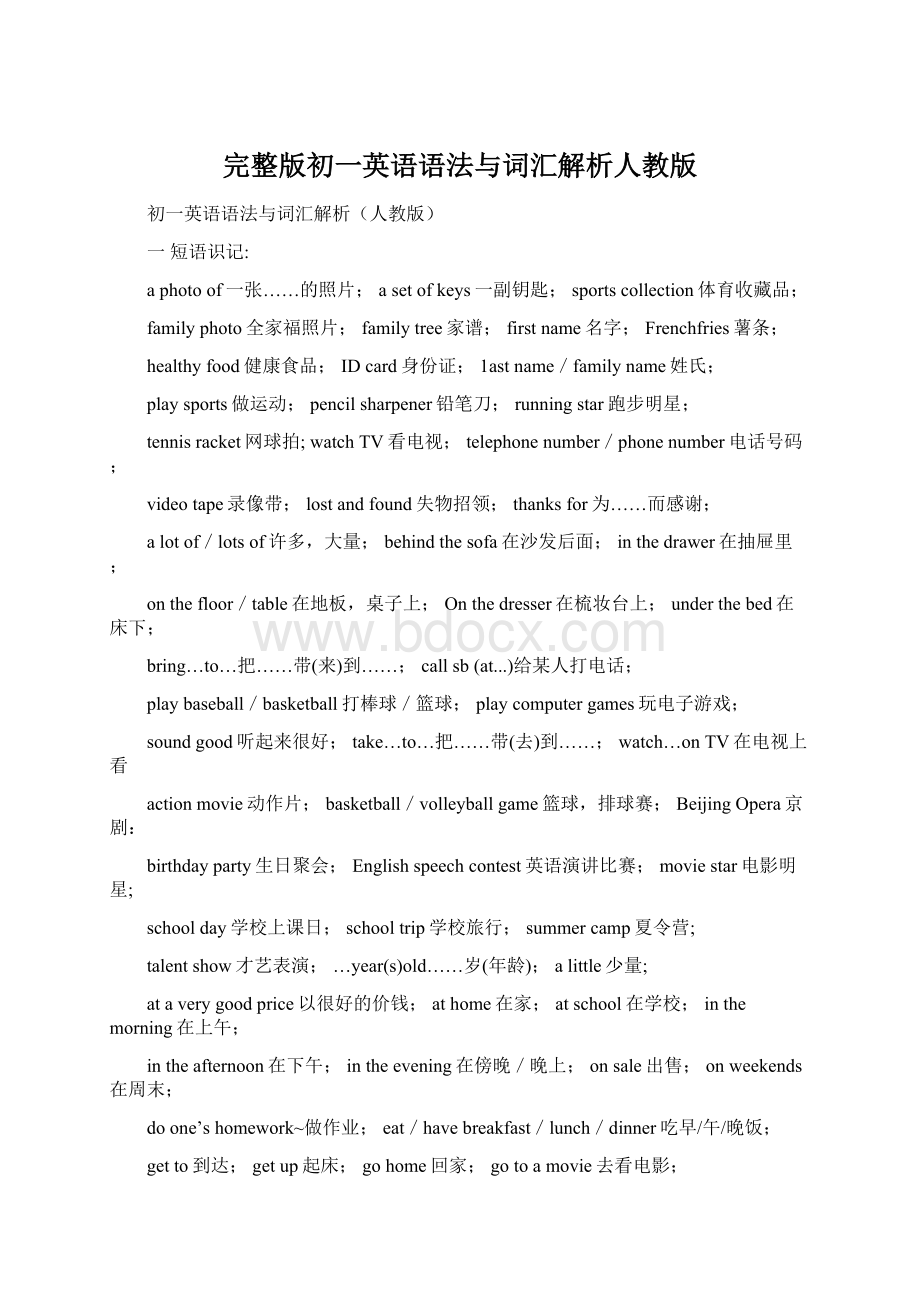完整版初一英语语法与词汇解析人教版.docx
《完整版初一英语语法与词汇解析人教版.docx》由会员分享,可在线阅读,更多相关《完整版初一英语语法与词汇解析人教版.docx(13页珍藏版)》请在冰豆网上搜索。

完整版初一英语语法与词汇解析人教版
初一英语语法与词汇解析(人教版)
一短语识记:
aphotoof一张……的照片;asetofkeys一副钥匙;sportscollection体育收藏品;
familyphoto全家福照片;familytree家谱;firstname名字;Frenchfries薯条;
healthyfood健康食品;IDcard身份证;1astname/familyname姓氏;
playsports做运动;pencilsharpener铅笔刀;runningstar跑步明星;
tennisracket网球拍;watchTV看电视;telephonenumber/phonenumber电话号码;
videotape录像带;lostandfound失物招领;thanksfor为……而感谢;
alotof/lotsof许多,大量;behindthesofa在沙发后面;inthedrawer在抽屉里;
onthefloor/table在地板,桌子上;Onthedresser在梳妆台上;underthebed在床下;
bring…to…把……带(来)到……;callsb(at...)给某人打电话;
playbaseball/basketball打棒球/篮球;playcomputergames玩电子游戏;
soundgood听起来很好;take…to…把……带(去)到……;watch…onTV在电视上看
actionmovie动作片;basketball/volleyballgame篮球,排球赛;BeijingOpera京剧:
birthdayparty生日聚会;Englishspeechcontest英语演讲比赛;moviestar电影明星;
schoolday学校上课日;schooltrip学校旅行;summercamp夏令营;
talentshow才艺表演;…year(s)old……岁(年龄);alittle少量;
ataverygoodprice以很好的价钱;athome在家;atschool在学校;inthemorning在上午;
intheafternoon在下午;intheevening在傍晚/晚上;onsale出售;onweekends在周末;
doone’shomework~做作业;eat/havebreakfast/lunch/dinner吃早/午/晚饭;
getto到达;getup起床;gohome回家;gotoamovie去看电影;
gotobed上床睡觉;gotoschool去上学;gotowork去上班;helpwith在……(方面)帮助;
learnabout了解有关……;listento听……;lookat/havealookat看一看……;
playchess下棋;playtheguitar/trumpet/violin/drum弹吉他/吹喇叭,拉小提琴,敲鼓;
playwith…和……;speakEnglish说英语;takeashower淋浴,洗漂;
takethenumber17bus乘17路公共汽车;howmuch(价钱)多少;howold多大年记;whattime几点,什么时候
二复习本册主要内容,包括话题、词汇、句型及语法:
一词汇分类记忆
1.schoolthings(学习及相关用品):
pencilpenbookeraserrulermathbookpencilcasepencilsharpenerbackpacknotebookcomputerwatchkeyringCDvideocassettealarmclockIDcard
2.familymembers(家庭成员):
motherfatherparentsisterbrothergrandmothergrandfathergrandparentuncleauntcousin
3.furniture(家具):
tablebeddresserbookcasesofachair
4.sportsandentertainment(运动与娱乐):
baseballbasketballvolleyballsoccerbattennisdanceswimmingpaintplaychessplaytheguitar
5.food(食物):
hamburgerstomatoesbroccoliorangessaladbananaseggscarrotsappleschickenfruitvegetablebreakfastlunchdinnerFrenchfriesicecream
6.clothes(衣物):
hatsockspantsshortssweaterbagT-shirt
7.number(数词):
cardinal(基数词)/ordinal(序数词)
one/firsttwo/secondthree/thirdfour/fourthfive/fifthsix/sixthseven/seventheight/eighthnine/ninthten/tentheleven/eleventhtwelve/twelfththirteen/thirteenthfourteen/fourteenthfifteen/fifteenthnineteen/nineteenthtwenty/twentieth
twenty-one/twenty-firstthirty/thirtieth
8.month(月份):
JanuaryFebruaryMarchAprilMayJuneJulyAu-gustSeptemberOctoberNovemberDecember
9.week(星期):
MondayTuesdayWednesdayThursdayFridaySaturdaySunday
10.movies(电影):
actionmoviecomedyromancethriller
11.musicalinstrument(乐器):
guitardrumpianotrumpetviolin
12.subject(科目):
mathsciencehistoryartChineseEnglishSpanishPortugueseKoreanFrenchphysicaleducation(P.E.)
13.countriesandcities(国家与城市):
CanadaNewZealandJapanAustraliaMexicoBrazilArgentina
SeoultheUnitedStatestheUnitedKingdomSouthKoreaNewYorkMexicoCityTokyo
14.dailylife(日常生活):
runcleanreadgetupeat/havebreakfast/lunch/suppergotoschool
dohomework/houseworkwatchTVgotobedtakeashower
15.adjectives(形容词):
interestingboringfundifficultrelaxingscary
funnyexcitingsadgreat
二主要语法项目
1.be动词的一般现在时形式
be动词的现在式有am,is,are三种形式,原形均为be,因此称它们为be动词。
be动词在一般现在时的句子当中,通常构成主系表句型,表示当前所存在的状态,句型如下:
肯定句:
主语+be动词+其他e.g.Iamateacher.
否定句:
主语+be动词+not+其他e.g.Heisn’tastudent.
疑问句:
Be动词+主语+其他e.g.Areyouasoccerplayer?
be动词的三种不同的形式分别接在不同的主语后面,第一人称单数Iam,第一人称复数weare.第二人称单复数youare,第三人称的单数she/he/itis,第三人称复数theyare。
注意下列缩写形式:
isnot=isn’tarenot=aren’t
Iamnot=I’mnot
Youare=You’reItis=It’s
看下列例句:
(1)Itisnotabook./Itisn’tabook.-
(2)一IsMaryanurse?
一Yes,sheis.
2do/does引导的一般疑问句、否定句及肯定、否定回答
be动词(am,is,are)、助动词、情态动词以外的动词称为行为动词。
行为动词通常用于主谓宾句型当中作谓语,表示一定的动作。
在否定句和疑问句中,要加助动词d0/does,这和be动词不同。
句型如下:
肯定句:
主语+动词(第三人称单数时,动词一s/-es)
否定句:
主语+do/doesnot(don’t/doesn’t)+动词
一般疑问句:
Do/Does+主语+动词?
e.g.
(1)Yougotoschooleveryday.
(2)Shelikessingingverymuch.
(3)Idon’twatchTvathome.
(4)Hedoesn’tstudyhard.
(5)一DoyouhaveanexaminationinEnglish?
一Yes,Ido.
(6)一Doesshewalktoschool?
一No,shedoesn’t.
3.人称代词、物主代词用法巧记和提示
巧学妙记
1.人称代词的用法口诀
人称代词分两格,主格宾格来分说;主格定把主语做,宾格作宾不会错。
如:
HeteachesusEnglish.
2.物主代词用法口诀
物主代词两类型,形容词性、名词性。
形容词性作定语,后面定把名词用①;名词性,独立用,主宾表语它都扮②
①形容词性物主代词具有形容词的特性,在句中用作定语,后面必须接名词。
如:
Ourteacherisayoungwoman.
②名词性物主代词应独立使用.后面不跟名词。
相当于形容词性物主代词+名词。
它在句中可作主语、宾语或表语。
如:
HerEnglishisbetterthanmine.Her作定语,mine=myEnglish。
提示
当几个不同的人称代词作主语时。
它们的排列顺序通常是:
①单数为:
you,he/sheandI如:
You,sheandIaregoodfriends.我、你和她都是好朋友。
MaryandIareinClassOne.我和玛丽在一班。
’
②复数为:
we,youandthey如:
We,youandtheyallenjoymusic.我们、你们和他们都喜欢音乐。
但如果是做错了事,当事人应承担责任时,通常把第一人称放在最前面。
如:
一Whobrokethewindow?
—IandMike.
这正是:
单数人称2、3、l,复数人称l、2、3。
麻烦事情“我”站前,其他人称没意见。
4.情态动词梳理归纳can(could),may(might),must,haveto,need,should
Can1.表示主观能力,意为“能;会”。
其否定形式为cannot=can’to如:
Hecan/can’tswim.
2.表示请求、许可,常用于“CanI…?
”,意为“我可以……吗?
”。
比较口语化。
如:
CanIplayfootballafterIfinishdoingmyhomework?
3.表示推测,常用于否定和疑问句中。
如:
Lookatthenameonthebag.Itcan’tbeLily’s.
Wherecanitbe?
May1.表示请求、许可,意为“可以”。
如:
MayIhavealookatyourCDplayer?
2.表示可能性(说话人的猜测),常用于肯定句中。
如:
Yourfriendmaybewaitingforyounow.
相关链接:
1.may引起的一般疑问句,其肯定回答多用“Yes,please.”或“Ofcourse/Certainly.”;其否定回答多用“Pleasedon’t.”或“No,youmustn’t.”。
如:
—MayIsmokehere?
一Yes.please./No.youmustn’t.
2.might是may的过去式,可用于间接引语中指过去。
如:
,
Hetoldmethatitmightbetrue.
3.might也可用于指现在,但语气比may较委婉,含义更不确定。
如:
Thatmightbequiteexpensive.
Must1.表示说话人的主观意志,意为“必须”,这种“必须”多出于义务、责任或强制命令。
如:
Youmustdoityourself.
2.表示推测,意为“一定”,语气较肯定,只用于肯定句中。
如:
Lookatourneighbor’snewcar.Theymustearnalotofmoney.
相关链接:
1.对must引起的一般疑问句,作肯定回答佣must,但作否定回答要用needn’t。
如:
--MustIwashtheclothesnow?
一Yes,youmust./No,youneedn’t.
2.must的否定式为mustnot/mustn’t,意为“不允许;禁止”。
如:
Thechildrenmustn’tplayfootballinthestreet.
Haveto1.表示客观需要,意为“不得不”。
有人称、时态和数的变化。
如:
HehastowaitforDrWangintheoffice.
2.haveto的否定和疑问形式要借助于助动词do/does/did构成。
如:
Whydoyouhavetoworksohard?
Need用作情态动词时,意为“需要”,主要用于否定和疑问句中。
如:
Youneedn’tworryabouther.
Needyougotoschoolnow?
相关链接:
1.need引起的一般疑问旬,其肯定回答要用must,而否定回答要用needn’t。
如:
一NeedItakethecameratoyourhouse?
一Yes,youmust./No,youneedn’t.
2.need还可以作实义动词,除了有人称、时态和数的变化外,其否定和疑问形式要借助于助动词do/does/did构成。
如:
Heneededtoescape.
Idon’tneedanythingspecial.
3.need作实义动词时,后面既可以跟v—ing形式也可以跟动词不定式。
Should表示道义上或责任上的“应该”。
可用于各种句式。
如:
Youshouldcallthepohceifyouseesomethingunusual.
Youshouldn’tmakesuchafoolishdecision.
UnitOne
1.Howoftendoyouexercise?
→Howoften+助动词do(does或did)+主语+dosth.?
疑问词howoften是问频率(多经常),在这里助动词do(does或did)是起帮助构成疑问的作用
Everyday/Onceaweek/Twiceamonth/Threetimesamonth/Threeorfourtimesamonth.
2.Whatdoyouusuallydoonweekends?
第一个do为助动词,在这起帮助构成疑问的作用;而第二个do则是实义动词。
Iusuallyplaysoccer.
3.What’syourfavoriteprogram?
It’sAnimalWorld.
4.WhatdostudentsdoatGreenHighSchool?
第一个do为助动词,在这起帮助构成疑问的作用;而第二个do则是实义动词。
5.Asforhomework,moststudentsdohomeworkeveryday.asfor...意思是“至于;关于”,常用于句首作状语,其后跟名词、代词或动词的-ing形式(即动名词)。
如:
Asforhim,Ineverwanttoseehimhere.至于他,我永远不希望在这里见到。
Asforthestory,you'dbetternotbelieveit.关于那故事,你最好不要相信。
6.Theresultsfor“watchTV”areinteresting.
7.Momwantsmetogetupat6:
00andplayping-pongwithher.→wanttodosth.意思是“想要做某事”;wantsb.todosth.意思是“想要某人做某事”。
如:
Doyouwanttogotothemovieswithme?
你想和我一起去看电影吗?
Theteacherdoesn'twantustoeathamburgers.老师不想让我们吃汉堡包。
8.Shesaysit’sgoodformyhealth.→begoodfor...表示“对……有益(有好处)”。
其反义为:
bebadfor...。
(这里for是介词,后跟名词、代词或动名词)如:
It'sgoodforustodomorereading.多读书对我们有好处。
Readinginbedisbadforyoureyes.在床上读书对你的眼睛有害。
9.Howmanyhoursdoyousleepeverynight?
10.Iexerciseeveryday,usuallywhenIcomehomefromschool.
11.Myeatinghabitsareprettygood.这里pretty相当于very。
12.Itrytoeatalotofvegetables,usuallytentoeleventimesaweek.→trytodosth.表示“尽力做某事”,不包含是否成功的意思/trydoingsth.表示“(用某一办法)试着去做某事”。
如:
You’dbettertrydoingtheexperimentinanotherway.你最好试试用另一种方法做这个试验。
13.Myhealthylifestylehelpsmegetgoodgrades.→helpsb.(to)dosth.帮助某人做某事
14.Goodfoodandexercisehelpmetostudybetter.→helpsb.(to)dosth.帮助某人做某事/这里better是well的比较级,而不是good的比较级
15.Isherlifestylethesameasyoursordifferent?
=Isherlifestylethesameasyourlifestyleorisherlifestyledifferentfromyourlifestyle?
→bethesameas…/bedifferentfrom…
16.IthinkI’mkindofunhealthy.kindof=alittle/akindof意思是“一种”
17.Whatsportsdoyouplay?
18.Alotofvegetableshelpyoutokeepingoodhealth.keepingoodhealth=keephealthy=stayhealthy
19.Youmusttrytoeatlessmeat.→trytodosth.表示“尽力做某事”,不包含是否成功的意思/less是little的比较级
20.Thatsoundsinteresting.这是“主语+系动词+表语”结构的简单句。
sound(听起来),look(看起来),smell(闻起来),taste(尝起来),feel(觉得),seem(好象),grow(变得),get(变得)等词在英语中可用作系动词,后跟形容词作表语。
如:
Ittastesgood.这味道好。
Themusicsoundsverysweet.这音乐听起来很入耳。
Thesmokegrewheavierandheavier.烟雾变得越来越浓了。
UnitTwo
1.What’sthematter?
What’sthematerwithyou?
with为介词,后跟名词、代词或动名词。
人称代词必须用它的宾格。
Ihaveacold/haveasoreback/haveastomachache
2.Youshouldliedownandrest/drinkhotteawithhoney/seeadentist/seeadoctor.
3.I’mnotfellingwell.这里well表示身体状况,不能用good代替
4.Wh